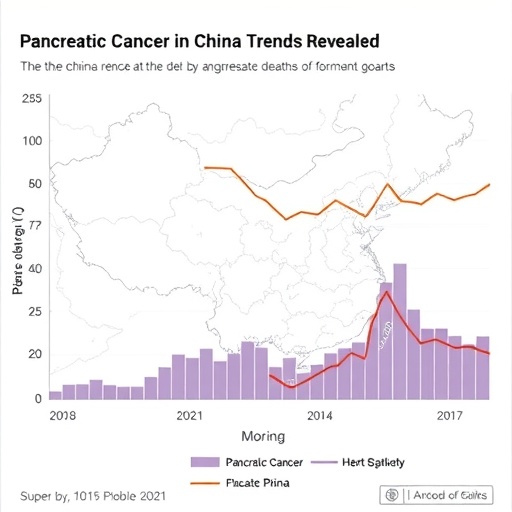
Over the past two decades, pancreatic cancer has emerged as a formidable public health challenge worldwide, with mortality rates climbing inexorably. A recent comprehensive study published in BMC Cancer presents a meticulous analysis of pancreatic cancer mortality trends in China from 2004 to 2021. Utilizing robust epidemiological data, this research offers unprecedented insights into how demographic and regional factors influence the lethality of this aggressive malignancy, painting a complex portrait of an evolving epidemic within the world’s most populous nation.
At the heart of the analysis lies data sourced from China’s national Disease Surveillance Point (DSP) system, a nationally representative dataset renowned for its broad population coverage and reliability. This large-scale dataset enabled researchers to disaggregate pancreatic cancer mortality across critical dimensions—age, gender, and geographic locale—yielding granular insights into the uneven burden of this disease. The study leveraged advanced statistical methodologies, including age-period-cohort (APC) modeling, to dissect temporal trends and identify nuanced mortality shifts over the 18-year period.
The findings reveal a disturbing amplification in pancreatic cancer mortality rates throughout China, underscoring the relentless progression of this disease despite modern medical advances. Particularly alarming is the pronounced increase observed among male populations, who not only exhibited higher baseline mortality rates but also steeper upward trajectories compared to females. This gender disparity aligns with lifestyle risk factors such as tobacco smoking and alcohol consumption, which remain more prevalent among men, thus potentially exacerbating disease susceptibility.
Age emerged as another critical determinant, with older adults demonstrating significantly heightened mortality risks. The aging Chinese population, propelled by demographic transitions and increased life expectancy, likely fuels this surge in pancreatic cancer deaths. Such insights underscore the imperative for age-tailored public health interventions and highlight the complexities introduced by an aging demographic landscape in disease management.
Geographic disparities feature prominently in the study’s conclusions, reflecting a mosaic of risk influenced by socioeconomic and healthcare access variables. Urban centers consistently exhibited higher pancreatic cancer mortality rates, a trend attributable in part to lifestyle factors linked to modernization, including dietary patterns and environmental exposures. Intriguingly, however, the growth rate of mortality in rural regions outpaced that in cities, signaling a shifting burden that may correlate with evolving risk profiles and the lagging availability of adequate medical infrastructure in less developed areas.
Further regional analysis delved into China’s diverse landscape, revealing that the eastern provinces, despite bearing the highest absolute mortality rates, experienced slower increases compared to the central and western regions. These latter zones, traditionally underserved and economically less developed, appear to be experiencing a burgeoning pancreatic cancer crisis. Limited healthcare resources, delayed diagnosis, and inferior access to specialized treatment facilities likely compound mortality risks in these areas, illuminating stark healthcare inequality challenges.
In addition to demographic and spatial analyses, the study underscored several pivotal risk factors driving pancreatic cancer mortality trends. Aging and chronic comorbidities such as diabetes were prominent contributors, reflecting their role in creating a conducive biological environment for tumor development. Moreover, chronic pancreatitis—an inflammatory condition of the pancreas—was identified as an important precursor and risk enhancer. The interplay between these medical conditions and pancreatic carcinogenesis underscores the multifactorial nature of the disease.
Crucially, gender-specific lifestyle factors emerged as significant modifiers of pancreatic cancer risk. Elevated smoking rates among males, coupled with higher alcohol consumption, likely potentiate carcinogenic pathways unique to this population group. The research calls attention to the need for gender-sensitive prevention frameworks that address these behavioral determinants to mitigate mortality disparities effectively.
Methodologically, the employment of the age-period-cohort model allowed for a sophisticated parsing of temporal effects distinguishing the influences of aging, generational shifts, and period-specific environmental or policy changes. This approach strengthened the robustness of mortality trend interpretations by controlling for confounding elements, offering a dynamic perspective on how pancreatic cancer lethality has evolved in the Chinese context.
The implications of this research transcend epidemiological quantification, beckoning an urgent recalibration of public health priorities in China. The study’s revelations underscore the necessity of comprehensive, targeted interventions encompassing early detection, lifestyle modification, and improved healthcare delivery, particularly in rural and underserved central and western regions. The disparities elucidated emphasize that a one-size-fits-all approach is inadequate for addressing China’s heterogeneous pancreatic cancer landscape.
Furthermore, the findings advocate for the amplification of health education initiatives focusing on modifiable risk factors such as smoking cessation and diabetes management. Given the disease’s aggressive nature and often late-stage diagnosis, primary prevention becomes a cornerstone in altering mortality trajectories.
Critical to future advances is the study’s call for more granular, individual-level data to enrich understanding of pancreatic cancer pathogenesis in heterogeneous Chinese populations. This data could illuminate complex gene-environment interactions, uncover novel biomarkers, and refine risk stratification models, fostering precision medicine approaches tailored to distinct demographic segments.
The increasing mortality trends observed signal that despite incremental improvements in healthcare infrastructure and awareness, pancreatic cancer remains a stealthy killer evading early diagnosis and effective treatment. Investment in diagnostic innovation, such as advanced imaging and biomarker screening, alongside expanded training of oncology specialists in rural areas, could bridge current mortality gaps.
Researchers also highlight the importance of integrating multidisciplinary strategies, encompassing oncology, endocrinology, and public health, to holistically address the interconnected risk factors like diabetes and pancreatitis that coalesce to propel pancreatic cancer risk upward.
In summary, the comprehensive 18-year analysis charts a sobering trajectory of rising pancreatic cancer mortality across China. With demographic shifts, lifestyle patterns, and regional disparities intertwining, the disease poses escalating challenges requiring multifaceted, equity-focused responses. This landmark study provides an evidentiary foundation essential for shaping policy, guiding clinical practice, and invigorating research aimed at subverting the surge of pancreatic cancer deaths in China’s dynamic population landscape.
Ultimately, this research invites global attention to a cancer whose shadow lengthens in tandem with societal transformations. Urgent, scientifically informed interventions targeting vulnerable populations could alter the current course and alleviate the heavy human toll exacted by pancreatic cancer moving forward.
Subject of Research: Pancreatic cancer mortality trends in China, analyzed by age, gender, and regional disparities from 2004 to 2021.
Article Title: Pancreatic cancer mortality in China from 2004 to 2021: an in-depth analysis of age, gender, and regional disparities
Article References:
He, R., Shen, Z., Chen, Q. et al. Pancreatic cancer mortality in China from 2004 to 2021: an in-depth analysis of age, gender, and regional disparities. BMC Cancer 25, 891 (2025).
Image Credits: Scienmag.com
DOI:
Tags: advanced statistical methodologies in cancer researchage-period-cohort modeling in cancer researchdemographic factors in cancer mortalityepidemiological study of pancreatic cancerhealthcare implications of rising cancer ratesincreasing pancreatic cancer rates in meninsights into aggressive malignancies in Chinamortality analysis from national Disease Surveillance Pointpancreatic cancer mortality trends in Chinapublic health challenges of pancreatic cancerregional differences in pancreatic cancer deathstrends in cancer mortality over two decades






No Comments
Leave a comment Cancel